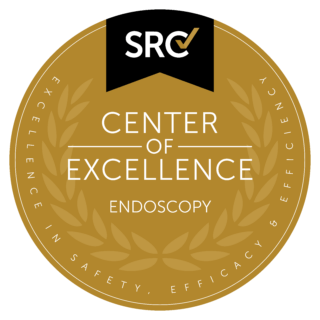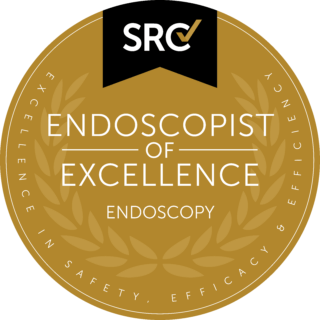EUS, which is short for Endoscopic Ultrasound, is a minimally invasive specialized procedure that is used to examine the digestive tract and its surrounding organs for a more detailed analysis. The procedure combines the use of a scope to look inside the GI tract, and ultrasound which uses high frequency sound waves to take pictures of the surrounding organs. The procedure is performed by a specially trained gastroenterologist.
The endoscopic ultrasound consists of a small ultrasound probe on the tip which emits high frequency sound waves that bounce off on the surrounding organs, which are then recaptured by the probe and converted into images.
When is an EUS Used?
An endoscopic ultrasound is used to evaluate different types of conditions and diseases including:
- Cancer of the pancreas
- Chronic pancreatitis
- Pancreatic cysts
- Bile duct stones
- Gallbladder stones
- Acute pancreatitis
- Abnormalities in the liver
- Determining the severity of stomach cancers
- Abnormalities in the digestive system
- Assess the cause of recurrent pancreatitis
- Administer medication in cases of abdominal pain as a result of pancreatic cancer
In cases where an abnormality is detected during the endoscopic ultrasound procedure, then a biopsy can also be done at the same time. A biopsy takes a sample of tissue and/or fluids from the target area for further investigations under a microscope. The biopsy is done using either Fine Needle Aspiration (FNA), or a Fine Needle Biopsy (FNB) technologies.
During an Endoscopic Ultrasound with FNA or FNB, a thin hollow needle is passed through the endoscope, guided by the ultrasound, and once it reaches the area of concern, the needle takes samples of the abnormality which has been detected.
In other cases, an endoscopic ultrasound is also used to perform a guided Celiac Plexus Block (CPB), also known as EUS guided pain control, which is a minimally invasive procedure that injects medication to the celiac plexus nerves in order to control pain and discomfort associated with pancreatic cancer or chronic pancreatitis.
What’s the Difference Between Endoscopic Ultrasound and Normal Endoscopy?
An endoscopic ultrasound is used to examine the gastrointestinal (GI) tract and its surrounding organs including the lungs for signs of any disease as well as the extent of the said disease. The procedure is less invasive and is done under a local anesthesia. A thin flexible tube that has a probe on the tip is inserted through the mouth or anus and into the GI tract. Detailed images of the target area are taken via high frequency soundwaves produced by the ultrasound, which is attached to the probe.
A normal endoscopy is performed using an endoscope, which is also a thin flexible tube that is passed through the mouth or rectum(anus) to observe the lining of the GI tract with the aim of removing samples of tissues for a biopsy, as well as visually aiding in operating on the target areas. The endoscope used in a normal endoscopy procedure has a camera attached to it which shows images of the internal organs on a television screen. There are different types of endoscopies, which depend on the area to be assessed and where the scope is to be inserted.
When is an EUS used, and when is a normal endoscopy used?
A normal endoscopy is used to identify various conditions in the GI tract such as cancer, celiac diseases, gastroesophageal reflux diseases, ulcers, swelling /inflammation, narrowing of the esophagus(strictures) and any pre-cancerous abnormalities. It is also used to aid in the treatment of these conditions as the surgeon can see the target area in real time while performing a procedure.
Endoscopic ultrasound on the other hand is efficient in indicating the stage of GI tract cancers or tumors, identifying whether the lesions are malignant and how far they have spread, as well as taking samples and fluids for further examination.
Endoscopic Ultrasound Vs Traditional Ultrasound
Endoscopic ultrasound involves inserting a thin tube into the mouth, passing it through the stomach and into the first part of the small intestine. The procedure provides high quality detailed images of the organs and structures in the target area.
Traditional ultrasound or standard abdominal ultrasound on the other hand is performed with a transducer which is placed on the skin above the area of interest, whereby it transmits soundwaves to and from the organs in order to obtain images. The images obtained using traditional ultrasound are of lower quality with minimal details compared to the ones obtained with the endoscopic ultrasound, which are more accurate.
Why Should You Choose an EUS?
Although both traditional ultrasound and endoscopic ultrasound are used to examine organs in the gastrointestinal tract, the endoscopic ultrasound is considered superior when it comes to getting optimal results, which is key for an effective diagnosis and treatment.
Some of the benefits of EUS include:
- High quality and accurate images of the area in question
- If an abnormality is detected, a biopsy can be done at the same time of the procedure
- In case of the presence of any cancerous cells, an EUS can determine the extent of the cancer and if it has metastasized (spread)
- Research has shown that EUS is very useful in confirming certain underlying disorders such as pancreatic conditions including pancreatic cancer, liver disorders, and gallbladder disease among others
- EUS can be used to administer medications especially in cases like Celiac Plexus Block (CPB) for patients with pancreatic cancer
- The results of an EUS are immediate after the procedure. However, in cases where an endoscopic ultrasound with Fine Needle Aspiration (FNA) or a Fine Needle Biopsy (FNB) has been performed during the procedure, the results may take a bit of time since the samples harvested have to be examined by a pathologist
- The procedure is outpatient, and lasts for approximately 30 minutes
Does Endoscopic Ultrasound Have Any Risks?
Although an endoscopic ultrasound is considered a fairly safe procedure, just like any other medical procedure, it comes with its own rare risks. These include:
- Reaction to anaesthesia because general anaesthesia is usually used during the procedure
- Perforation of the gastrointestinal tract during the procedure which can be managed endoscopically (this risk is considered to be less than 1%)
- Acute pancreatitis as a result of a EUS biopsy with FNA or FNB. This can occur as a result of bleeding, inflammation or infection after taking a sample from the pancreas
- Infection of the cyst in cases of pancreatic cyst biopsy. To prevent this from happening, you doctor may give you an antibiotic before the procedure.


احجز موعدًا


